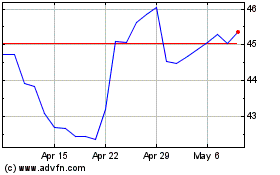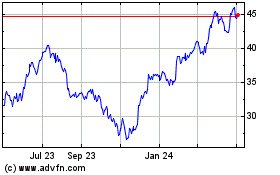By Eric Morath
WASHINGTON -- The U.S. economy has cooled but continues to
expand with employers hiring, consumers spending and growth
stabilizing.
Employment grew by a seasonally adjusted 128,000 jobs in
October, the Labor Department reported Friday, a solid performance
considering a strike at General Motors plants and a decline in the
federal workforce temporarily reduced payrolls by more than
50,000.
The unemployment rate ticked up from a 50-year low to 3.6% in
October as hundreds of thousands of Americans joined the labor
force. Wage growth remained steady, up 3% from a year earlier.
Friday's figures also showed job growth was stronger in August
and September than previously reported. That and other economic
news point to a U.S. economy that is growing at a stable but slower
rate compared with 2018, despite signs of global slowdown.
"The U.S. economy is in a good place," Federal Reserve Vice
Chairman Richard Clarida said in a speech Friday afternoon. "Growth
has been supported by the continued strength of household
consumption, underpinned, in turn, by a thriving labor market."
The Fed this week cut its benchmark interest rate for the third
time since July in an attempt to stimulate the economy and signaled
it was done cutting rates unless it sees a significant slowing of
economic activity. After Friday's report, JPMorgan Chase and
Barclays economists removed a projected fourth interest-rate cut in
December from their forecast.
Corporate profits have been better than expected, and economic
growth has returned to the 2% trajectory that marked most of the
expansion before the tax cuts passed in late 2017. Growth has
slowed from a 3% rate in the middle of last year, but new data this
week suggests recession risks remain low.
Stocks climbed Friday after the October jobs figures comforted
investors about U.S. growth.
U.S. employers overall have added to payrolls for 109 straight
months, by far the longest stretch of consistent job creation on
record to 1939. Employers added an average 167,000 jobs to payrolls
each month this year. That is a slowdown from the 223,000 jobs
added each month, on average, last year, and on pace to be the
worst year for job creation since 2010.
But job growth remains strong in areas of the economy that serve
U.S. consumers and are generally shielded from global trends and
trade disputes. Health care and social services added 34,200 jobs
in October, business services added 22,000, and hospitality,
including restaurants, added 61,000.
Outside the automotive sector, which was cutting jobs even
before the GM strike, manufacturers have added more than 100,000
jobs in the past 12 months. While less than half as many as the
prior 12 months, continued growth points to a cooling, not
collapsing, factory sector.
With the unemployment rate low and the economy in a decadelong
expansion, diners are as hungry as ever for tacos, said Michael
Mabry, chief development officer of Fuzzy's Taco Shops, a Fort
Worth, Texas chain of 150 restaurants in 17 states. The company is
planning to add between 15 and 20 locations by the end of next
year, an expansion that would create several hundred new jobs, Mr.
Mabry said.
"The industry itself is stable, and our company is having some
pretty good months, so it's stacking up to be a pretty good year,"
he said, but added that finding and retaining workers can be
challenging. The firm's restaurants are trying to become more
efficient by redesigning kitchens to reduce the number of prep
cooks and combining bartender and cashier jobs during slower
periods of the day, he said.
October's hiring was consistent with recent trends, after
accounting for two anomalies last month.
Employment in auto manufacturing fell by 41,600 "reflecting
strike activity," according to the Labor Department. The 40-day GM
strike ended last week, but the government didn't count those
workers on payrolls in October because they were on picket lines
the week of the employer survey. The federal government shed 17,000
jobs because many temporary workers completed their jobs for the
2020 census. The Census is planning to add a half-million temporary
jobs next year.
Still, with the economy clearly downshifting from 2018, some
U.S. employers are acting cautiously.
Melissa Ball, owner of Ball Office Products, is holding staffing
steady at her 30-person company in Richmond, Va.
"We have a good sense of comfort right now but not a lot of
long-term security," she said. Tariffs led to higher prices for
some products, she said. More generally, Ms. Ball said she is
preparing for a slowdown after some strong years. "I'm not going to
hire someone that I don't feel really confident about their
employment prospects with us for a long time," she said.
The unemployment rate last month rose in part because more
Americans joined the labor force, a positive sign.
The share of Americans working or searching for work rose last
month to the highest level since August 2013, hinting the labor
market is drawing some Americans off the sidelines. Participation
among those in their prime working years, between 25 and 54,
touched a 10-year high.
Wage growth has largely plateaued despite a low unemployment
rate; historically, wages are pushed up when workers are in short
supply. Average hourly earnings for private-sector workers
increased 6 cents to $28.18 an hour.
Wages last year accelerated to grow at better than a 3% rate
from a year earlier for the first time in a decade. Since peaking
at a 3.4% increase in February, pay increases have eased somewhat.
The gains well outpace inflation, but are modest relative to other
periods with historically low unemployment. That suggests many
businesses are reluctant to boost wages enough to poach workers
from competitors. Some maybe turning to benefits, such as offering
remote work or additional vacation, to attract employees.
Nick Timiraos contributed to this article.
Write to Eric Morath at eric.morath@wsj.com
(END) Dow Jones Newswires
November 01, 2019 14:44 ET (18:44 GMT)
Copyright (c) 2019 Dow Jones & Company, Inc.
General Motors (NYSE:GM)
Historical Stock Chart
From Aug 2024 to Sep 2024

General Motors (NYSE:GM)
Historical Stock Chart
From Sep 2023 to Sep 2024
